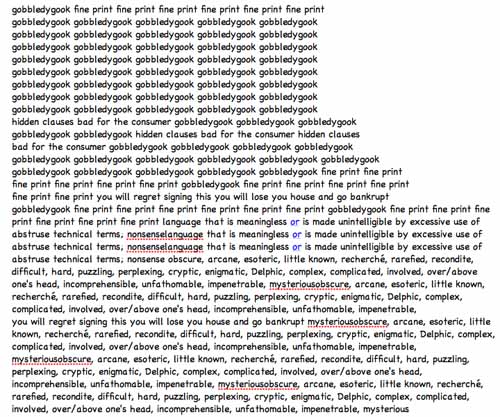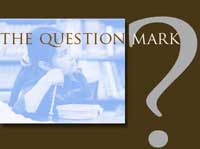Reading (and Questioning) the Fine Print
by Jamie McKenzie
About Author


Unless we teach citizens to read, question and understand the fine print of their lives, they will remain susceptible to scams, schemes and flimflam artists. The Oxford American Writer's Thesaurus supplies the following words to convey the meaning of susceptible:
|
credulous, gullible, innocent, ingenuous, naive, easily led; defenseless, vulnerable; persuadable, tractable; sensitive, responsive, thin-skinned |
-
The collapse of the housing market and the mortgage industry in the USA illustrates the consequences of poor comprehension and questioning skills as millions of families signed bad agreements and as financial institutions foolishly lent money to poor credit risks. Many of the families did not comprehend what they were doing or signing; but it seems likely that those who made big profits from granting risky loans did understand. One group lacked comprehension. The other group lacked conscience.
True Literacy
The USA is suffering from years of misguided educational policy under NCLB that paid too little attention to thinking, questioning, comprehension and information literacies. A number of reports have documented a national crisis in reading comprehension as the NCLB champions pushed a reading agenda that dumbed down instruction so that students could sound out words without necessarily understanding them.
Note article, "Adolescent Literacy: Putting the Crisis in Context" by Jacobs, Vicki A, in the Spring 2008 issue of The Harvard Educational Review.
Also note "Reading next: A vision for action and research in middle and high school literacy" (PDF file) Biancarosa & Snow, 2006 - a report to the Carnegie Corporation that concludes that there is a "A Literacy Crisis" in the U.S.A. among adolescent readers.
In its Fact Sheet (PDF), The Alliance for Excellent Education reports:
- Adolescent Literacy (February 2006)
In recent years, policy makers have directed considerable resources toward improving the literacy skills of the nation’s youngest schoolchildren, with the goal of helping every child to master the basics of reading by the end of the third grade. However, America’s adolescents face a literacy crisis every bit as alarming as that which confronts their younger siblings. According to The Nation’s Report Card, fewer than one third of eighth graders read at a proficient level. Today, millions of students are leaving school unprepared for college, work, and the many demands of adulthood.
Heavily scripted reading programs have deprived millions of children of the comprehension skills they need to be good citizens and capable consumers. Many schools laid aside important learning goals in order to pass AYP on reading and math. Many states dumbed down their tests to create the illusion of progress.
True literacy empowers students to make sense of a dozen or more categories of information ranging from numbers and text to photographs, paintings, body language, videos and many others. They learn to read a face, to read a mortgage agreement, to read a poem and to read a photograph.
Comprehension and Questioning
The capacity to make sense of complex and confounding information is directly tied to questioning skills. Those who know how to pose pertinent questions are able to puzzle their way through the fog and mystification so typical of these times.
Mystification is an issue for the average homeowner and citizen as well as for the banker, the broker and the regulators. Those who have watched the U.S. Congress face the financial crisis of summer and fall of 2008, have witnessed struggle and bewilderment. Having passed a bailout program shortly before Election Day, it was only a matter of weeks before the Secretary of the Treasury had announced major shifts in how those funds would be deployed and members of Congress were holding hearings to find out what had happened. Bait and switch?
These members of Congress fired question after question at those in charge of the bailout to get the true story. Many of these questions began with the word "Why?" They employed questions like scalpels to uncover the truth.
Business Week published an November 19 article with the headline, "Paulson's Explanation Leaves More Questions."
- The congressional ire was bipartisan—and it went well beyond ideology. Conservative Representative Jeb Hensarling (R-Tex.) spoke for many of the plan's original opponents as he too fretted over the change. "It felt like a bait and switch," he said.
 |
Full Disclosure and Transparency
Truth has been elusive during recent months and during the past few years as the financial industry engaged in doubtful practices while presenting a positive public front. Without earnest regulators asking good questions to check the veracity of these claims, many companies were able to profit by building what amounted to sand castles. When the tides shifted, the towers collapsed along with the retirement accounts of millions.
|
The above cartoon appears in Chapter 18 of Leading Questions, "Investigating."
- This chapter will concentrate on how questioning may help us to uncover and then reveal the hidden truths, partial truths and secrets of our times. Organizations must develop this capacity so as to guard against bad contracts, dangerous partnerships, false promises, feints and deceptive practices.
Inference - Reading Between the Lines of Fine Print
The most difficult comprehension questions require inference - the capacity to read between the lines, putting clues together to fashion an idea not directly stated in the passage. This skill becomes especially important when reading documents written with language that seems designed to obscure the truth. The language may be jargon - "special words or expressions that are used by a particular profession or group that are difficult for others to understand" according to The Oxford American Writer's Thesaurus. The language may be vague and unclear, leaving important issues ill-defined to the advantage of the writer. Ironically, the document may rely upon silence to convey meaning, leaving out key information or elements that would normally be included. The savvy consumer looks past what is directly stated, knowing that much of the most important content may be concealed or implicit.
- What words do I need to look up?
- Who do I know who might help me translate this document and its language?
- What items are left ambiguous? Does that matter? Why?
- On what issues is the document silent? So what?

The above cartoon appears in Chapter 10 of Leading Questions, "Probing."
The label on the right describes the contents of a very small bag of croutons. This bag held barely enough croutons for one person to enjoy with the accompanying salad, yet it claims that this paltry collection amounts to 2.5 servings.
Without reading that fine print thoughtfully, the number of calories (35) seems quite small. If someone ate the entire bag, the true number of calories would be 2.5 times 35 = 87.5 calories!
Reading the Fine Print of History
Another opportunity to read fine print would be the primary source documents available to help us understand history and historical figures. The images we have of Joan of Arc, Captain James Cook and Thomas Jefferson may shift dramatically when we move past the icons presented by many historical accounts.
|
Teaching the Reading of Fine Print
in Schools
The reading of fine print should begin early in life, as early as elementary school, so that the young make it a practice to question what is nearly hidden from sight.
A good source of fine print would be the labels on food products claiming to list the nutritional characteristics of the contents.
Some of these food labels are more forthcoming than others.
|
|
|
Older students might study the personality and character of Joan as expressed in her letters and in the transcripts of her trials.
Source One - Joan of Arc's 'Letter to the English'
(22 March 1429)
Source Two - Saint Joan of Arc's Trial of Condemnation
Source Three - Saint Joan of Arc's Trial of Nullification
Once they have formed their own views of her character, they might contrast those views with the images projected in secondary sources like those below:
|
|
|
Source Four - Catholic Encyclopedia - St. Joan of Arc
Source Five - Wikipedia
Source Six - The Messenger: The Story of Joan of Arc (1999)

|
| This kind of reading requires the young to "make up their own minds" instead of merely swallowing what they are fed. They learn more than skill. They develop an attitude of healthy skepticism. They see that many documents have a sub text, that they must probe below the surface, check the footnotes and test the evidence presented to justify the ideas being presented (or sold.)
If journalists would read the fine print . . .
 It would be comforting if journalists would practice this reading skill with more vigor, as all too often groups will release studies that make important claims that rapidly claim headlines because the findings are dramatic in some way. Too few journalists review the methodology employed to develop these findings or ask for anything more than the executive summary of the study. This happened recently with a study paid for by a drug company suggesting the drug would be good even for folks with low cholesterol. It would be comforting if journalists would practice this reading skill with more vigor, as all too often groups will release studies that make important claims that rapidly claim headlines because the findings are dramatic in some way. Too few journalists review the methodology employed to develop these findings or ask for anything more than the executive summary of the study. This happened recently with a study paid for by a drug company suggesting the drug would be good even for folks with low cholesterol.
Few of the early media stories raised issues about this report's funding and weaknesses, but here and there over the next few days, the report's critics were able to win the attention of some members of the press so that these issues did eventually receive attention. Note article, "Cholesterol-Fighting Drugs Show Wider Benefit" By Pam Belluck, published: November 9, 2008 in The New York Times. The Times even published an editorial on November 18 stressing these issues and concerns "Who should take a statin?".
- A large new study seems to suggest that millions of people with low cholesterol could benefit from taking the cholesterol-lowering drugs known as statins. That would be a boon for some drug companies, but whether it would be good for all patients remains an open question.
Given the paper's series of articles challenging many of the studies that have been used to sell drugs, "The Evidence Gap," the editorial is not surprising, but the cholesterol study first won major headlines across the nation through the AP and Times newsfeeds while the subsequent articles challenging the study appeared mostly on back pages if at all. The Times article cited above should carry the headline, "Cholesterol-Fighting Drugs May Produce Wider Benefit." As worded, the headline conceals the uncertainties and promotes the drug.
|
|
|









 It would be comforting if journalists would practice this reading skill with more vigor, as all too often groups will release studies that make important claims that rapidly claim headlines because the findings are dramatic in some way. Too few journalists review the methodology employed to develop these findings or ask for anything more than the executive summary of the study. This happened recently with a study paid for by a drug company suggesting the drug would be good even for folks with low cholesterol.
It would be comforting if journalists would practice this reading skill with more vigor, as all too often groups will release studies that make important claims that rapidly claim headlines because the findings are dramatic in some way. Too few journalists review the methodology employed to develop these findings or ask for anything more than the executive summary of the study. This happened recently with a study paid for by a drug company suggesting the drug would be good even for folks with low cholesterol.